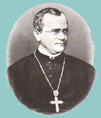
Gregor Mendel in 1865 (David Paterson)
|
|
|
|
|
|
|
|
|
|
|
|
|
|
|
|
|
|
 |
Gregor Mendel in 1865 (David Paterson) |
WHO WAS GREGOR MENDEL?
Gregor Johann MENDEL was an Austrian monk and biologist whose work on heredity became the basis of the modern theory of genetics.
Mendel was born on July 22, 1822 in Heizendorf, Austria, (now known as Hyncice in Czechoslovakia). He was born Johann Mendel into a poor farming family. At that time it was difficult for poor families to obtain a good education and the young Mendel saw the only way to escape a life of poverty was to enter the monastery at Brunn in Moravis, (now Brno in Czechoslovakia). Here he was given the name Gregor. This monastery was the Augustinian Order of St Thomas, a teaching order with a reputation as a centre of learning and scientific enquiry.
MENDEL THE FAILURE
To enable him to further his education, the abbot arranged for Mendel to attend the University of Vienna to get a teaching diploma. However, Mendel did not perform well. He was nervous and the University did not consider him a clever student. Mendel's examiner failed him with the comments, " he lacks insight and the requisite clarity of knowledge". This must have been devastating to the young Mendel. who in 1853 had to return to the monastery as a failure. As this was a teaching order, Mendel had to decide whether to stay on at the monastery as a failed teacher - or return to what?
WHAT TO DO NEXT?
While studying in Vienna, Mendel had been impressed by the work of a biologist called Frank Unger whose practical view of inheritance, free from spiritual influences, seemed to reflect his own farming background. This gave Mendel the idea to stay on at the monastery and use his time to carry out practical experiments in biology. He must have had to approach the abbot very carefully to ask to be allowed to do this, as the bishop refused to allow the monks to even teach biology.

After about two years Mendel began his investigation into variation, heredity and evolution in plants. He chose to study in detail the common garden pea, Pisum, which he grew in the monastery garden.
 |
 |
Between 1856 and 1863 Mendel patiently cultivated and tested at least 28 000 pea plants, carefully analysing seven pairs of seeds for comparison, such as shape of seed, colour of seed, tall stemmed and short stemmed and tall plants and short plants. Mendel worked on this for several years, carefully self-pollinating and wrapping each individual plant to prevent accidental pollination by insects. He collected the seeds produced by the plants and studied the offspring of these seeds observing that some plants bred true and others not. Mendel discovered that by crossing tall and short parent plants he got hybrid offspring that resembled the tall parent rather than being a medium height blend. He explained this conceived the concept of heredity units, now called genes. These often expressed dominant or recessive characteristics. He then worked out the pattern of inheritance of various traits and produced two generalisations that became known as the laws of heredity. Mendel's observations led him to coin two terms which are still used in present-day genetics:
* dominance for a trait that shows up in an offspring
* recessiveness for a trait masked by a dominant gene.
WHAT
HAPPENED NEXT?
In 1866 Mendel published his work on heredity in the Journal of the Brno Natural History Society. It had absolutely no impact. The complex and detailed work he had produced was not understood even by influential people in his field such as Karl Nageli. If Mendel had been a professional scientist he might have been able to project his work more extensively and perhaps publish his work abroad. He did make some attempt to contact scientists abroad by sending them reprints of his work but this was a uphill struggle for an unknown author writing in an unknown journal.
1868 two years after Mendel had produced his paper he was elected abbot of the monastery and his work lay unrecognised for about 34 years.
For much of the remainder of his life, Mendel devoted himself to the duties of the monastery. He did continue with some breeding experiments, this time with bees. A natural progression, as he had always wanted to transfer his experiments from plants to animals. Mendel successfully produced a hybrid strain of bees which produced excellent honey, however, they were so vicious they stung everybody around for miles and had to be destroyed. Some of Mendel's later experiments with the hawkweed Hieracium were inconclusive and the pressures of running the monastery took over so he ended his experiments by the 1870's.
During his time as abbot Mendel seems to have been more concerned with the financial running of the monastery rather than the religious side. It is suggested Mendel was seen as unreliable by the Emperor's Secret Police. It is likely the bishop and many in the monastery did not like what Mendel was doing, particularly his interest and enthusiasm for the work of such contemporaries as Charles Darwin.
When Mendel died in 1884 aged 62, the Czech composer Leos Janacek played the organ at his funeral.
The new abbot of the monastery
burned all Mendel's papers.
MENDEL RE-DISCOVERED
In 1900 Mendel's work was at last recognised by three independent investigators. One of these being the Dutch botanist, Hugo De Vries. But it was still not until the early 1920s and early 1930s that the full significance of his work was recognised particularly in relation to evolutionary theory. As a result of years of research in population genetics, investigators were able to demonstrate that the Darwinian theory of evolution could be described in terms of the change in gene frequency of Mendelian pairs of characteristics in a population over successive generations.